Telemedicine for Cancer Care: Opportunities and Challenges
VerifiedAdded on 2020/05/28
|13
|3292
|48
AI Summary
This assignment delves into the application of telemedicine in cancer care. It examines the various advantages telemedicine offers, such as improved access to specialists for patients in rural areas and enhanced patient monitoring. The analysis also considers the challenges associated with telemedicine implementation, including privacy concerns, technological infrastructure requirements, and reimbursement policies. The overall aim is to assess the potential of telemedicine to revolutionize cancer care delivery in the near future.
Contribute Materials
Your contribution can guide someone’s learning journey. Share your
documents today.

1Running head: FINAL PROJECT
Final Project
Name of student:
Name of university:
Author note:
Final Project
Name of student:
Name of university:
Author note:
Secure Best Marks with AI Grader
Need help grading? Try our AI Grader for instant feedback on your assignments.
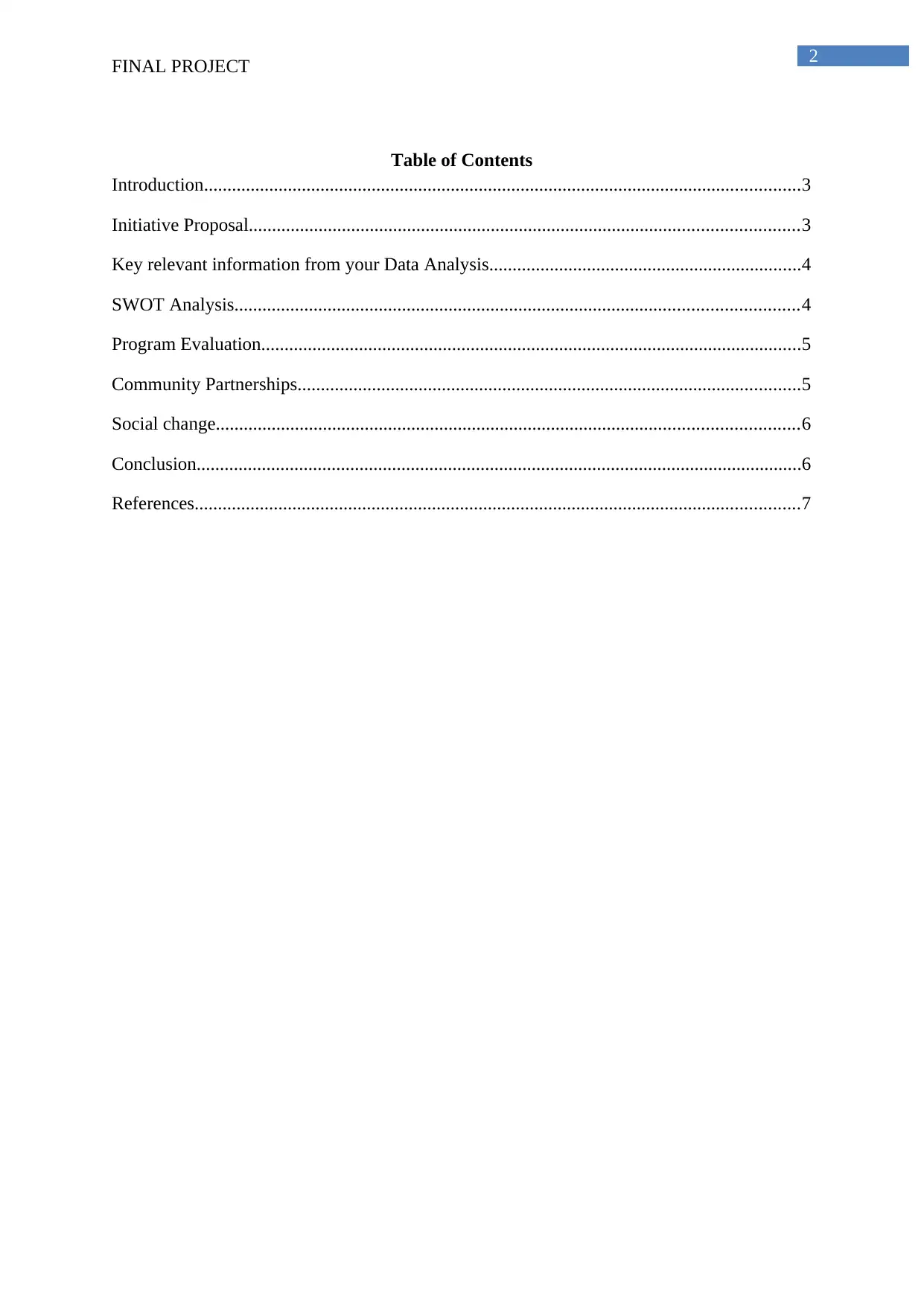
2
FINAL PROJECT
Table of Contents
Introduction................................................................................................................................3
Initiative Proposal......................................................................................................................3
Key relevant information from your Data Analysis...................................................................4
SWOT Analysis.........................................................................................................................4
Program Evaluation....................................................................................................................5
Community Partnerships............................................................................................................5
Social change.............................................................................................................................6
Conclusion..................................................................................................................................6
References..................................................................................................................................7
FINAL PROJECT
Table of Contents
Introduction................................................................................................................................3
Initiative Proposal......................................................................................................................3
Key relevant information from your Data Analysis...................................................................4
SWOT Analysis.........................................................................................................................4
Program Evaluation....................................................................................................................5
Community Partnerships............................................................................................................5
Social change.............................................................................................................................6
Conclusion..................................................................................................................................6
References..................................................................................................................................7
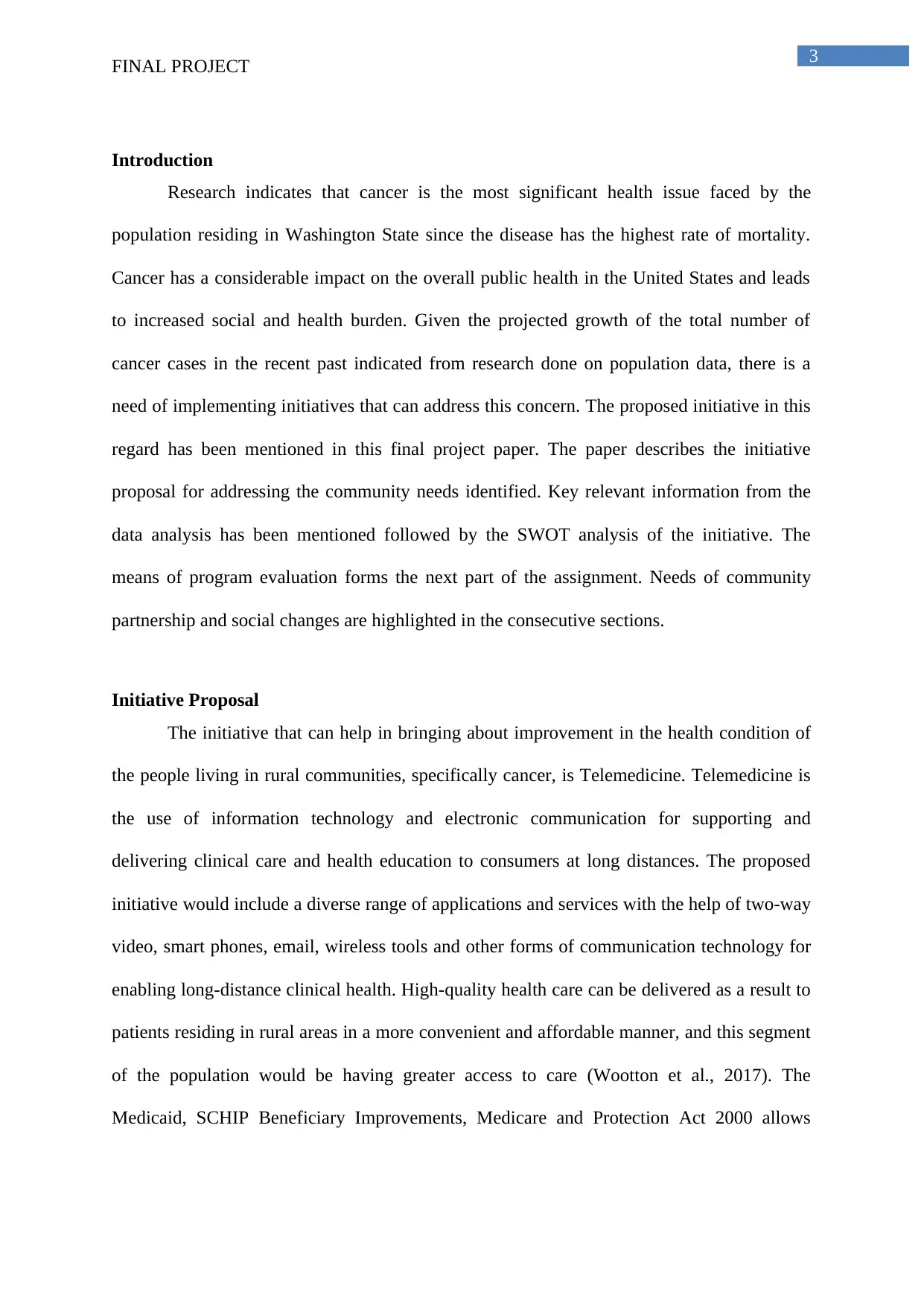
3
FINAL PROJECT
Introduction
Research indicates that cancer is the most significant health issue faced by the
population residing in Washington State since the disease has the highest rate of mortality.
Cancer has a considerable impact on the overall public health in the United States and leads
to increased social and health burden. Given the projected growth of the total number of
cancer cases in the recent past indicated from research done on population data, there is a
need of implementing initiatives that can address this concern. The proposed initiative in this
regard has been mentioned in this final project paper. The paper describes the initiative
proposal for addressing the community needs identified. Key relevant information from the
data analysis has been mentioned followed by the SWOT analysis of the initiative. The
means of program evaluation forms the next part of the assignment. Needs of community
partnership and social changes are highlighted in the consecutive sections.
Initiative Proposal
The initiative that can help in bringing about improvement in the health condition of
the people living in rural communities, specifically cancer, is Telemedicine. Telemedicine is
the use of information technology and electronic communication for supporting and
delivering clinical care and health education to consumers at long distances. The proposed
initiative would include a diverse range of applications and services with the help of two-way
video, smart phones, email, wireless tools and other forms of communication technology for
enabling long-distance clinical health. High-quality health care can be delivered as a result to
patients residing in rural areas in a more convenient and affordable manner, and this segment
of the population would be having greater access to care (Wootton et al., 2017). The
Medicaid, SCHIP Beneficiary Improvements, Medicare and Protection Act 2000 allows
FINAL PROJECT
Introduction
Research indicates that cancer is the most significant health issue faced by the
population residing in Washington State since the disease has the highest rate of mortality.
Cancer has a considerable impact on the overall public health in the United States and leads
to increased social and health burden. Given the projected growth of the total number of
cancer cases in the recent past indicated from research done on population data, there is a
need of implementing initiatives that can address this concern. The proposed initiative in this
regard has been mentioned in this final project paper. The paper describes the initiative
proposal for addressing the community needs identified. Key relevant information from the
data analysis has been mentioned followed by the SWOT analysis of the initiative. The
means of program evaluation forms the next part of the assignment. Needs of community
partnership and social changes are highlighted in the consecutive sections.
Initiative Proposal
The initiative that can help in bringing about improvement in the health condition of
the people living in rural communities, specifically cancer, is Telemedicine. Telemedicine is
the use of information technology and electronic communication for supporting and
delivering clinical care and health education to consumers at long distances. The proposed
initiative would include a diverse range of applications and services with the help of two-way
video, smart phones, email, wireless tools and other forms of communication technology for
enabling long-distance clinical health. High-quality health care can be delivered as a result to
patients residing in rural areas in a more convenient and affordable manner, and this segment
of the population would be having greater access to care (Wootton et al., 2017). The
Medicaid, SCHIP Beneficiary Improvements, Medicare and Protection Act 2000 allows
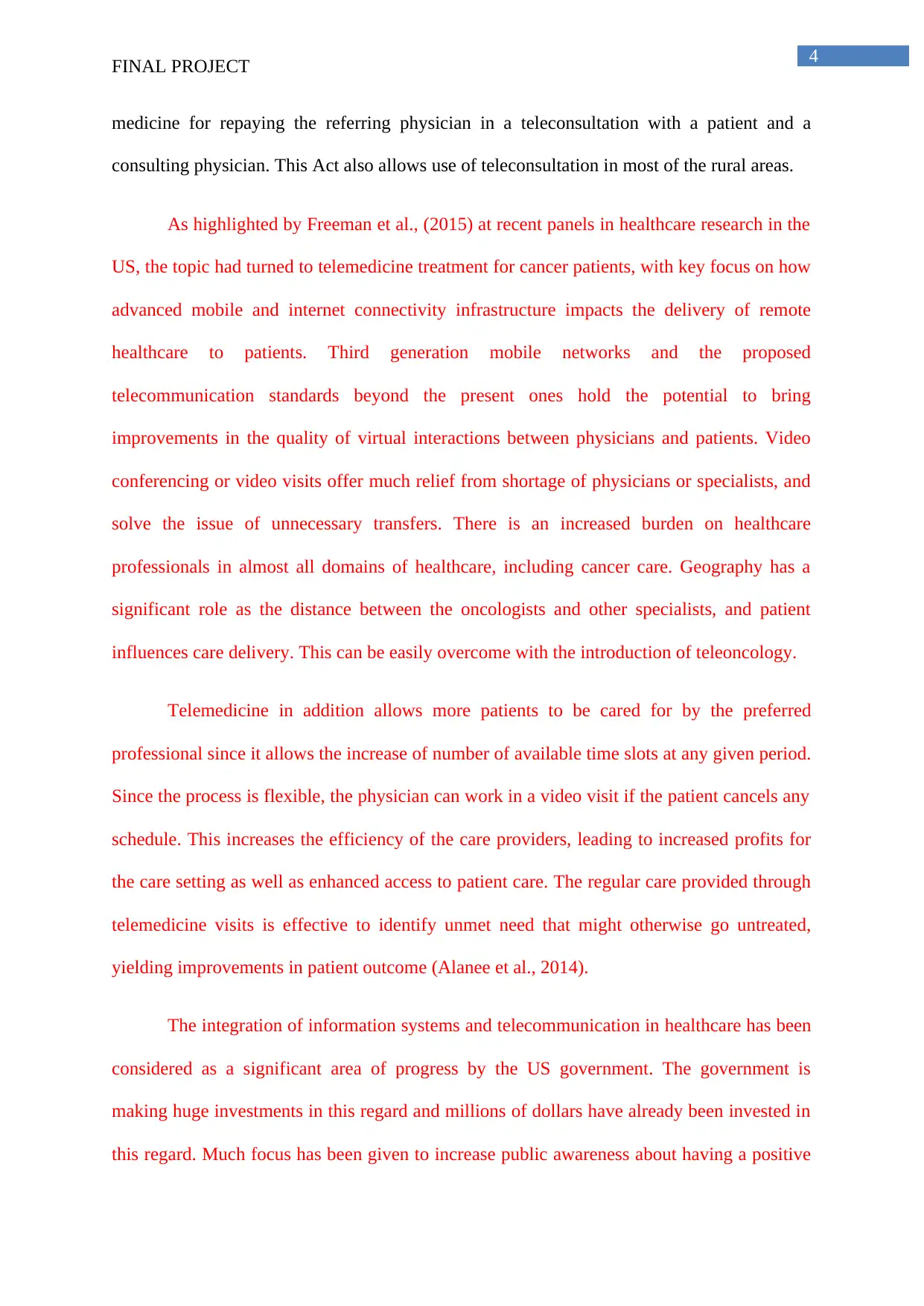
4
FINAL PROJECT
medicine for repaying the referring physician in a teleconsultation with a patient and a
consulting physician. This Act also allows use of teleconsultation in most of the rural areas.
As highlighted by Freeman et al., (2015) at recent panels in healthcare research in the
US, the topic had turned to telemedicine treatment for cancer patients, with key focus on how
advanced mobile and internet connectivity infrastructure impacts the delivery of remote
healthcare to patients. Third generation mobile networks and the proposed
telecommunication standards beyond the present ones hold the potential to bring
improvements in the quality of virtual interactions between physicians and patients. Video
conferencing or video visits offer much relief from shortage of physicians or specialists, and
solve the issue of unnecessary transfers. There is an increased burden on healthcare
professionals in almost all domains of healthcare, including cancer care. Geography has a
significant role as the distance between the oncologists and other specialists, and patient
influences care delivery. This can be easily overcome with the introduction of teleoncology.
Telemedicine in addition allows more patients to be cared for by the preferred
professional since it allows the increase of number of available time slots at any given period.
Since the process is flexible, the physician can work in a video visit if the patient cancels any
schedule. This increases the efficiency of the care providers, leading to increased profits for
the care setting as well as enhanced access to patient care. The regular care provided through
telemedicine visits is effective to identify unmet need that might otherwise go untreated,
yielding improvements in patient outcome (Alanee et al., 2014).
The integration of information systems and telecommunication in healthcare has been
considered as a significant area of progress by the US government. The government is
making huge investments in this regard and millions of dollars have already been invested in
this regard. Much focus has been given to increase public awareness about having a positive
FINAL PROJECT
medicine for repaying the referring physician in a teleconsultation with a patient and a
consulting physician. This Act also allows use of teleconsultation in most of the rural areas.
As highlighted by Freeman et al., (2015) at recent panels in healthcare research in the
US, the topic had turned to telemedicine treatment for cancer patients, with key focus on how
advanced mobile and internet connectivity infrastructure impacts the delivery of remote
healthcare to patients. Third generation mobile networks and the proposed
telecommunication standards beyond the present ones hold the potential to bring
improvements in the quality of virtual interactions between physicians and patients. Video
conferencing or video visits offer much relief from shortage of physicians or specialists, and
solve the issue of unnecessary transfers. There is an increased burden on healthcare
professionals in almost all domains of healthcare, including cancer care. Geography has a
significant role as the distance between the oncologists and other specialists, and patient
influences care delivery. This can be easily overcome with the introduction of teleoncology.
Telemedicine in addition allows more patients to be cared for by the preferred
professional since it allows the increase of number of available time slots at any given period.
Since the process is flexible, the physician can work in a video visit if the patient cancels any
schedule. This increases the efficiency of the care providers, leading to increased profits for
the care setting as well as enhanced access to patient care. The regular care provided through
telemedicine visits is effective to identify unmet need that might otherwise go untreated,
yielding improvements in patient outcome (Alanee et al., 2014).
The integration of information systems and telecommunication in healthcare has been
considered as a significant area of progress by the US government. The government is
making huge investments in this regard and millions of dollars have already been invested in
this regard. Much focus has been given to increase public awareness about having a positive
Secure Best Marks with AI Grader
Need help grading? Try our AI Grader for instant feedback on your assignments.
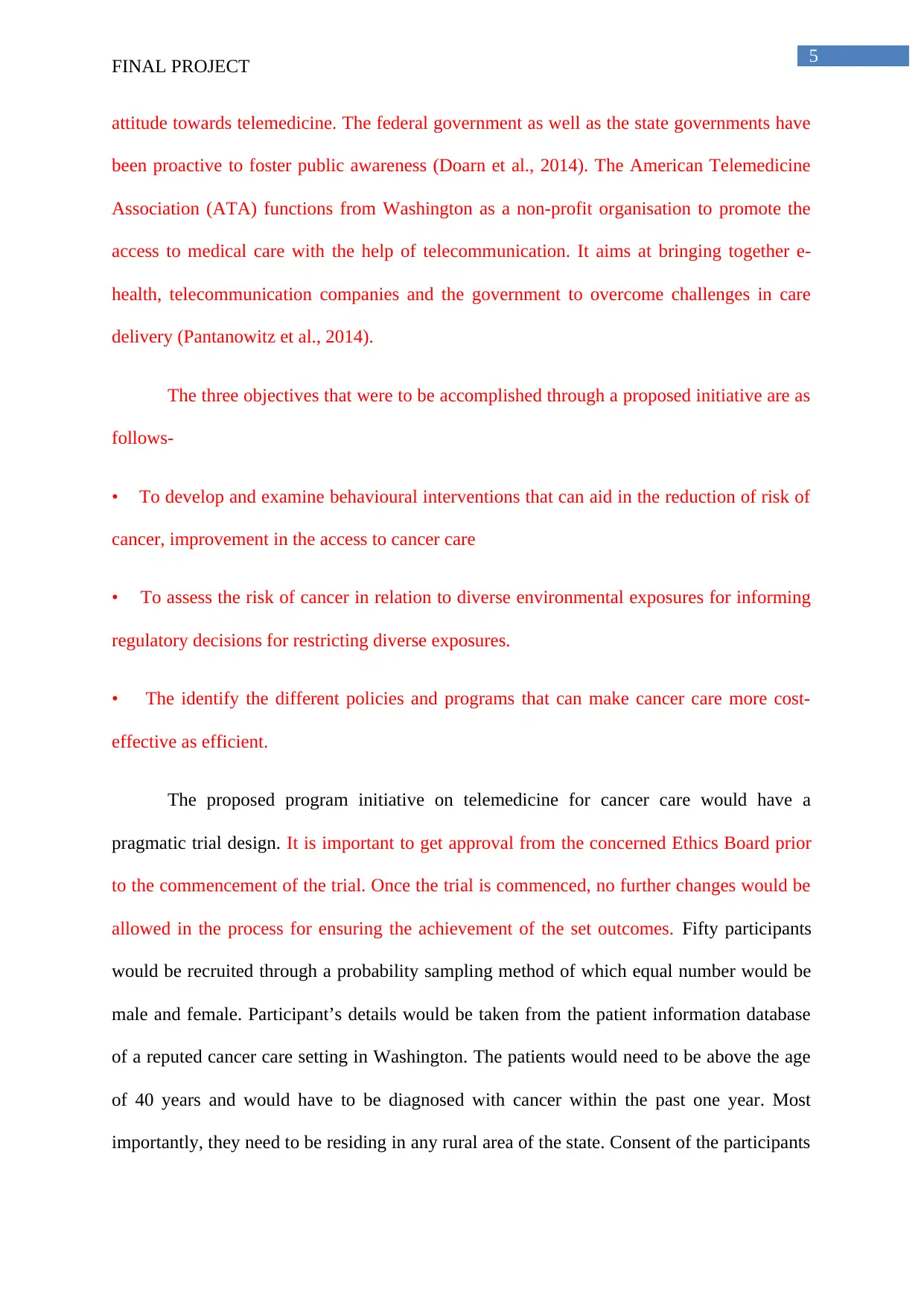
5
FINAL PROJECT
attitude towards telemedicine. The federal government as well as the state governments have
been proactive to foster public awareness (Doarn et al., 2014). The American Telemedicine
Association (ATA) functions from Washington as a non-profit organisation to promote the
access to medical care with the help of telecommunication. It aims at bringing together e-
health, telecommunication companies and the government to overcome challenges in care
delivery (Pantanowitz et al., 2014).
The three objectives that were to be accomplished through a proposed initiative are as
follows-
• To develop and examine behavioural interventions that can aid in the reduction of risk of
cancer, improvement in the access to cancer care
• To assess the risk of cancer in relation to diverse environmental exposures for informing
regulatory decisions for restricting diverse exposures.
• The identify the different policies and programs that can make cancer care more cost-
effective as efficient.
The proposed program initiative on telemedicine for cancer care would have a
pragmatic trial design. It is important to get approval from the concerned Ethics Board prior
to the commencement of the trial. Once the trial is commenced, no further changes would be
allowed in the process for ensuring the achievement of the set outcomes. Fifty participants
would be recruited through a probability sampling method of which equal number would be
male and female. Participant’s details would be taken from the patient information database
of a reputed cancer care setting in Washington. The patients would need to be above the age
of 40 years and would have to be diagnosed with cancer within the past one year. Most
importantly, they need to be residing in any rural area of the state. Consent of the participants
FINAL PROJECT
attitude towards telemedicine. The federal government as well as the state governments have
been proactive to foster public awareness (Doarn et al., 2014). The American Telemedicine
Association (ATA) functions from Washington as a non-profit organisation to promote the
access to medical care with the help of telecommunication. It aims at bringing together e-
health, telecommunication companies and the government to overcome challenges in care
delivery (Pantanowitz et al., 2014).
The three objectives that were to be accomplished through a proposed initiative are as
follows-
• To develop and examine behavioural interventions that can aid in the reduction of risk of
cancer, improvement in the access to cancer care
• To assess the risk of cancer in relation to diverse environmental exposures for informing
regulatory decisions for restricting diverse exposures.
• The identify the different policies and programs that can make cancer care more cost-
effective as efficient.
The proposed program initiative on telemedicine for cancer care would have a
pragmatic trial design. It is important to get approval from the concerned Ethics Board prior
to the commencement of the trial. Once the trial is commenced, no further changes would be
allowed in the process for ensuring the achievement of the set outcomes. Fifty participants
would be recruited through a probability sampling method of which equal number would be
male and female. Participant’s details would be taken from the patient information database
of a reputed cancer care setting in Washington. The patients would need to be above the age
of 40 years and would have to be diagnosed with cancer within the past one year. Most
importantly, they need to be residing in any rural area of the state. Consent of the participants
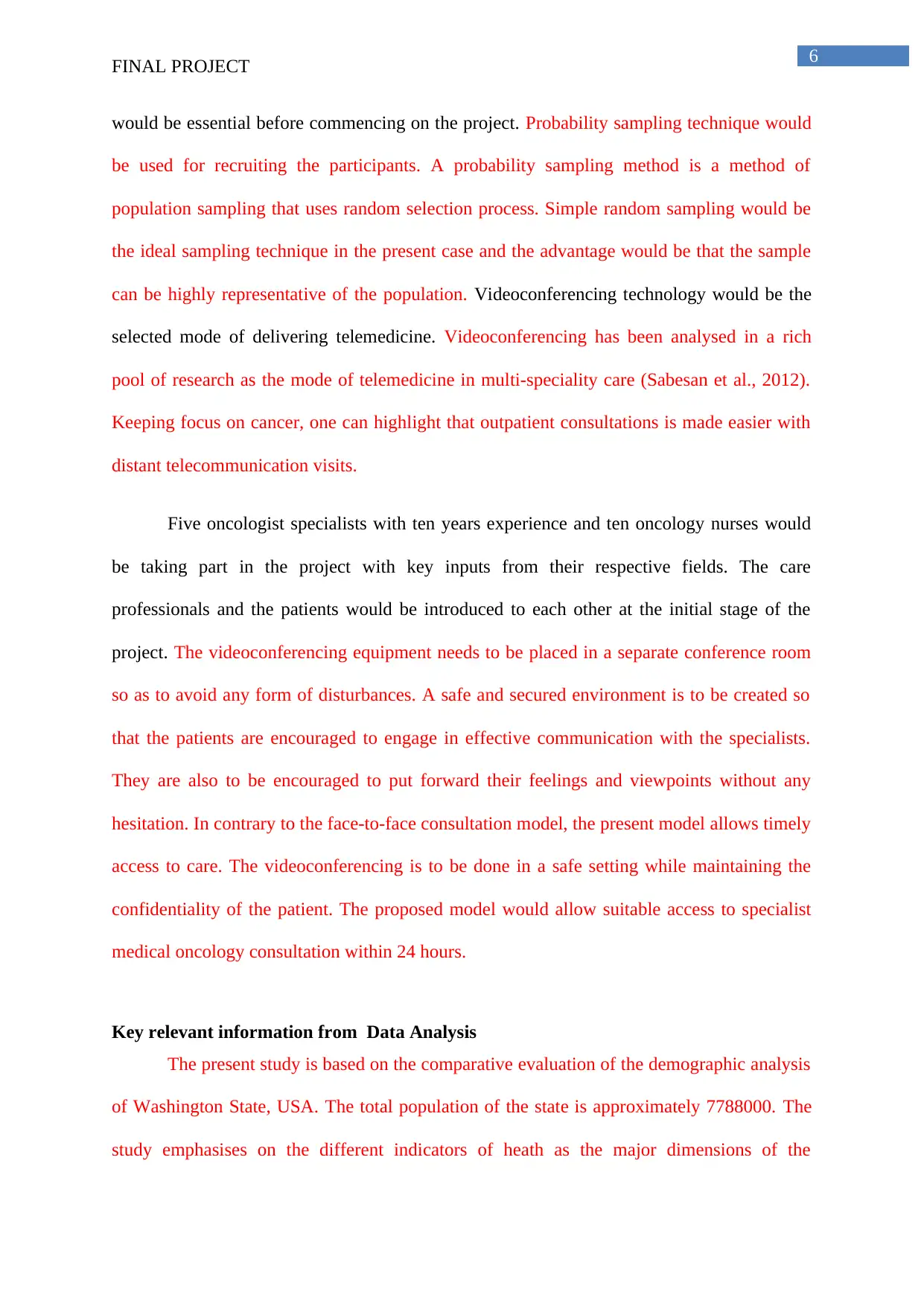
6
FINAL PROJECT
would be essential before commencing on the project. Probability sampling technique would
be used for recruiting the participants. A probability sampling method is a method of
population sampling that uses random selection process. Simple random sampling would be
the ideal sampling technique in the present case and the advantage would be that the sample
can be highly representative of the population. Videoconferencing technology would be the
selected mode of delivering telemedicine. Videoconferencing has been analysed in a rich
pool of research as the mode of telemedicine in multi-speciality care (Sabesan et al., 2012).
Keeping focus on cancer, one can highlight that outpatient consultations is made easier with
distant telecommunication visits.
Five oncologist specialists with ten years experience and ten oncology nurses would
be taking part in the project with key inputs from their respective fields. The care
professionals and the patients would be introduced to each other at the initial stage of the
project. The videoconferencing equipment needs to be placed in a separate conference room
so as to avoid any form of disturbances. A safe and secured environment is to be created so
that the patients are encouraged to engage in effective communication with the specialists.
They are also to be encouraged to put forward their feelings and viewpoints without any
hesitation. In contrary to the face-to-face consultation model, the present model allows timely
access to care. The videoconferencing is to be done in a safe setting while maintaining the
confidentiality of the patient. The proposed model would allow suitable access to specialist
medical oncology consultation within 24 hours.
Key relevant information from Data Analysis
The present study is based on the comparative evaluation of the demographic analysis
of Washington State, USA. The total population of the state is approximately 7788000. The
study emphasises on the different indicators of heath as the major dimensions of the
FINAL PROJECT
would be essential before commencing on the project. Probability sampling technique would
be used for recruiting the participants. A probability sampling method is a method of
population sampling that uses random selection process. Simple random sampling would be
the ideal sampling technique in the present case and the advantage would be that the sample
can be highly representative of the population. Videoconferencing technology would be the
selected mode of delivering telemedicine. Videoconferencing has been analysed in a rich
pool of research as the mode of telemedicine in multi-speciality care (Sabesan et al., 2012).
Keeping focus on cancer, one can highlight that outpatient consultations is made easier with
distant telecommunication visits.
Five oncologist specialists with ten years experience and ten oncology nurses would
be taking part in the project with key inputs from their respective fields. The care
professionals and the patients would be introduced to each other at the initial stage of the
project. The videoconferencing equipment needs to be placed in a separate conference room
so as to avoid any form of disturbances. A safe and secured environment is to be created so
that the patients are encouraged to engage in effective communication with the specialists.
They are also to be encouraged to put forward their feelings and viewpoints without any
hesitation. In contrary to the face-to-face consultation model, the present model allows timely
access to care. The videoconferencing is to be done in a safe setting while maintaining the
confidentiality of the patient. The proposed model would allow suitable access to specialist
medical oncology consultation within 24 hours.
Key relevant information from Data Analysis
The present study is based on the comparative evaluation of the demographic analysis
of Washington State, USA. The total population of the state is approximately 7788000. The
study emphasises on the different indicators of heath as the major dimensions of the
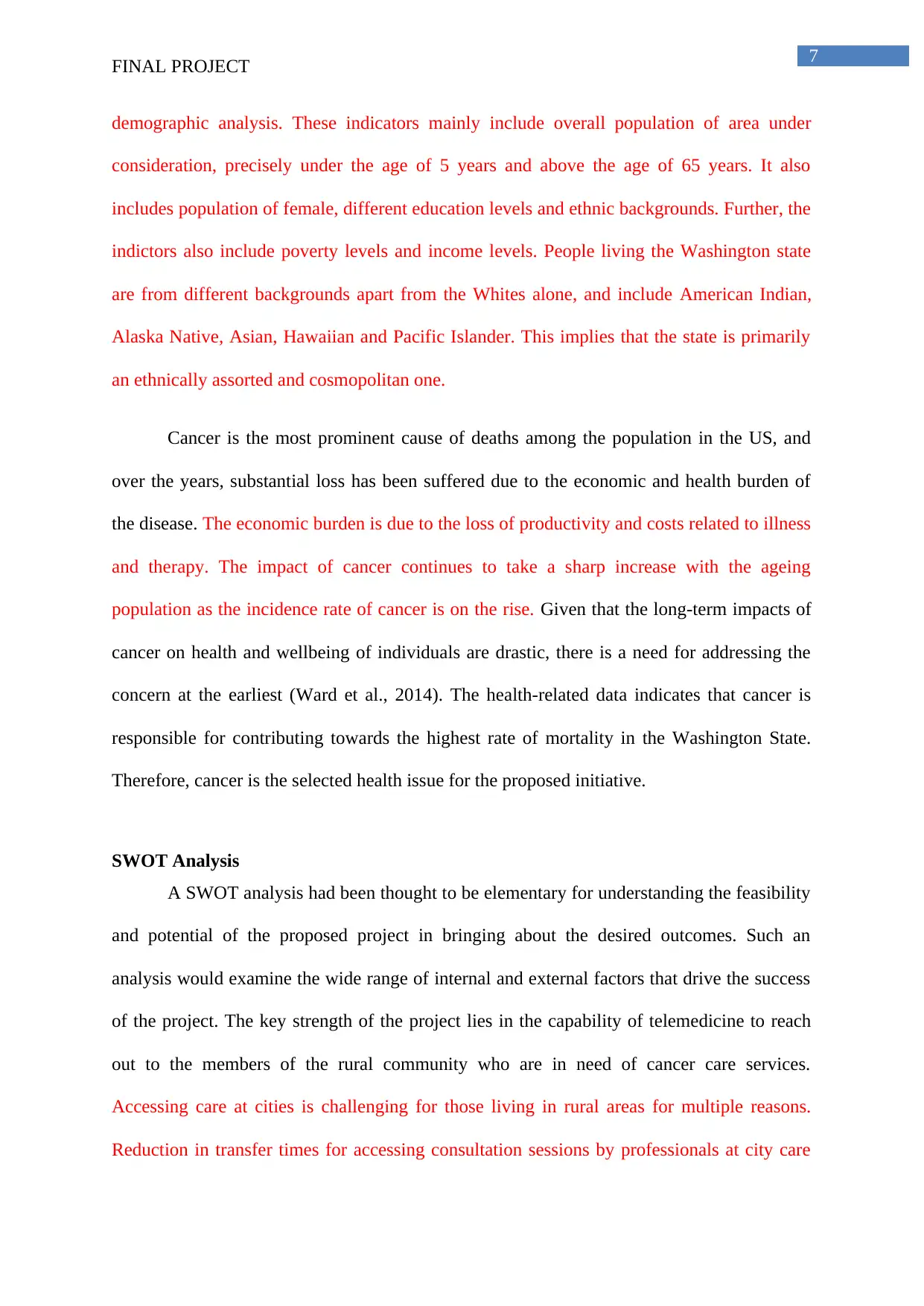
7
FINAL PROJECT
demographic analysis. These indicators mainly include overall population of area under
consideration, precisely under the age of 5 years and above the age of 65 years. It also
includes population of female, different education levels and ethnic backgrounds. Further, the
indictors also include poverty levels and income levels. People living the Washington state
are from different backgrounds apart from the Whites alone, and include American Indian,
Alaska Native, Asian, Hawaiian and Pacific Islander. This implies that the state is primarily
an ethnically assorted and cosmopolitan one.
Cancer is the most prominent cause of deaths among the population in the US, and
over the years, substantial loss has been suffered due to the economic and health burden of
the disease. The economic burden is due to the loss of productivity and costs related to illness
and therapy. The impact of cancer continues to take a sharp increase with the ageing
population as the incidence rate of cancer is on the rise. Given that the long-term impacts of
cancer on health and wellbeing of individuals are drastic, there is a need for addressing the
concern at the earliest (Ward et al., 2014). The health-related data indicates that cancer is
responsible for contributing towards the highest rate of mortality in the Washington State.
Therefore, cancer is the selected health issue for the proposed initiative.
SWOT Analysis
A SWOT analysis had been thought to be elementary for understanding the feasibility
and potential of the proposed project in bringing about the desired outcomes. Such an
analysis would examine the wide range of internal and external factors that drive the success
of the project. The key strength of the project lies in the capability of telemedicine to reach
out to the members of the rural community who are in need of cancer care services.
Accessing care at cities is challenging for those living in rural areas for multiple reasons.
Reduction in transfer times for accessing consultation sessions by professionals at city care
FINAL PROJECT
demographic analysis. These indicators mainly include overall population of area under
consideration, precisely under the age of 5 years and above the age of 65 years. It also
includes population of female, different education levels and ethnic backgrounds. Further, the
indictors also include poverty levels and income levels. People living the Washington state
are from different backgrounds apart from the Whites alone, and include American Indian,
Alaska Native, Asian, Hawaiian and Pacific Islander. This implies that the state is primarily
an ethnically assorted and cosmopolitan one.
Cancer is the most prominent cause of deaths among the population in the US, and
over the years, substantial loss has been suffered due to the economic and health burden of
the disease. The economic burden is due to the loss of productivity and costs related to illness
and therapy. The impact of cancer continues to take a sharp increase with the ageing
population as the incidence rate of cancer is on the rise. Given that the long-term impacts of
cancer on health and wellbeing of individuals are drastic, there is a need for addressing the
concern at the earliest (Ward et al., 2014). The health-related data indicates that cancer is
responsible for contributing towards the highest rate of mortality in the Washington State.
Therefore, cancer is the selected health issue for the proposed initiative.
SWOT Analysis
A SWOT analysis had been thought to be elementary for understanding the feasibility
and potential of the proposed project in bringing about the desired outcomes. Such an
analysis would examine the wide range of internal and external factors that drive the success
of the project. The key strength of the project lies in the capability of telemedicine to reach
out to the members of the rural community who are in need of cancer care services.
Accessing care at cities is challenging for those living in rural areas for multiple reasons.
Reduction in transfer times for accessing consultation sessions by professionals at city care
Paraphrase This Document
Need a fresh take? Get an instant paraphrase of this document with our AI Paraphraser
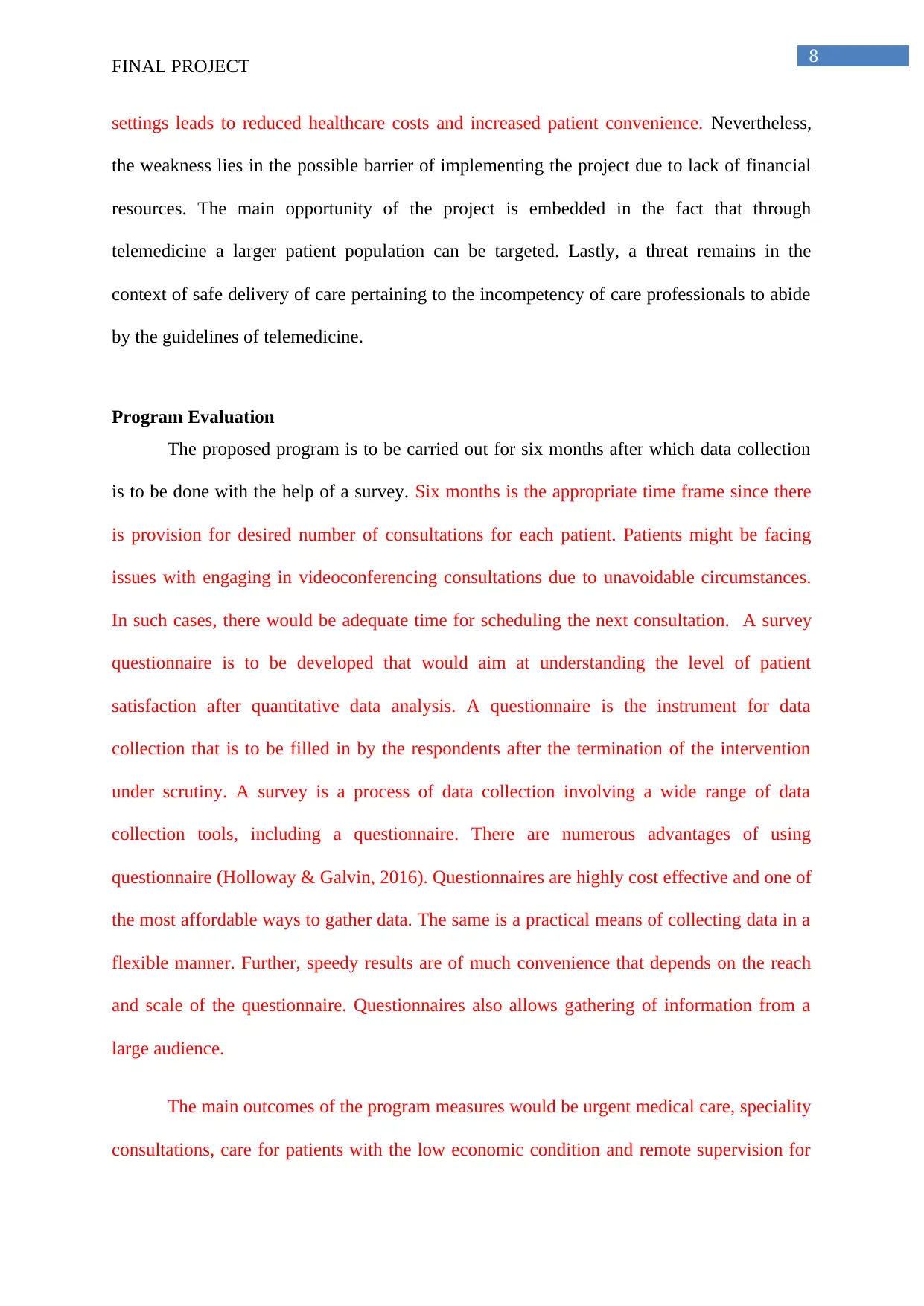
8
FINAL PROJECT
settings leads to reduced healthcare costs and increased patient convenience. Nevertheless,
the weakness lies in the possible barrier of implementing the project due to lack of financial
resources. The main opportunity of the project is embedded in the fact that through
telemedicine a larger patient population can be targeted. Lastly, a threat remains in the
context of safe delivery of care pertaining to the incompetency of care professionals to abide
by the guidelines of telemedicine.
Program Evaluation
The proposed program is to be carried out for six months after which data collection
is to be done with the help of a survey. Six months is the appropriate time frame since there
is provision for desired number of consultations for each patient. Patients might be facing
issues with engaging in videoconferencing consultations due to unavoidable circumstances.
In such cases, there would be adequate time for scheduling the next consultation. A survey
questionnaire is to be developed that would aim at understanding the level of patient
satisfaction after quantitative data analysis. A questionnaire is the instrument for data
collection that is to be filled in by the respondents after the termination of the intervention
under scrutiny. A survey is a process of data collection involving a wide range of data
collection tools, including a questionnaire. There are numerous advantages of using
questionnaire (Holloway & Galvin, 2016). Questionnaires are highly cost effective and one of
the most affordable ways to gather data. The same is a practical means of collecting data in a
flexible manner. Further, speedy results are of much convenience that depends on the reach
and scale of the questionnaire. Questionnaires also allows gathering of information from a
large audience.
The main outcomes of the program measures would be urgent medical care, speciality
consultations, care for patients with the low economic condition and remote supervision for
FINAL PROJECT
settings leads to reduced healthcare costs and increased patient convenience. Nevertheless,
the weakness lies in the possible barrier of implementing the project due to lack of financial
resources. The main opportunity of the project is embedded in the fact that through
telemedicine a larger patient population can be targeted. Lastly, a threat remains in the
context of safe delivery of care pertaining to the incompetency of care professionals to abide
by the guidelines of telemedicine.
Program Evaluation
The proposed program is to be carried out for six months after which data collection
is to be done with the help of a survey. Six months is the appropriate time frame since there
is provision for desired number of consultations for each patient. Patients might be facing
issues with engaging in videoconferencing consultations due to unavoidable circumstances.
In such cases, there would be adequate time for scheduling the next consultation. A survey
questionnaire is to be developed that would aim at understanding the level of patient
satisfaction after quantitative data analysis. A questionnaire is the instrument for data
collection that is to be filled in by the respondents after the termination of the intervention
under scrutiny. A survey is a process of data collection involving a wide range of data
collection tools, including a questionnaire. There are numerous advantages of using
questionnaire (Holloway & Galvin, 2016). Questionnaires are highly cost effective and one of
the most affordable ways to gather data. The same is a practical means of collecting data in a
flexible manner. Further, speedy results are of much convenience that depends on the reach
and scale of the questionnaire. Questionnaires also allows gathering of information from a
large audience.
The main outcomes of the program measures would be urgent medical care, speciality
consultations, care for patients with the low economic condition and remote supervision for
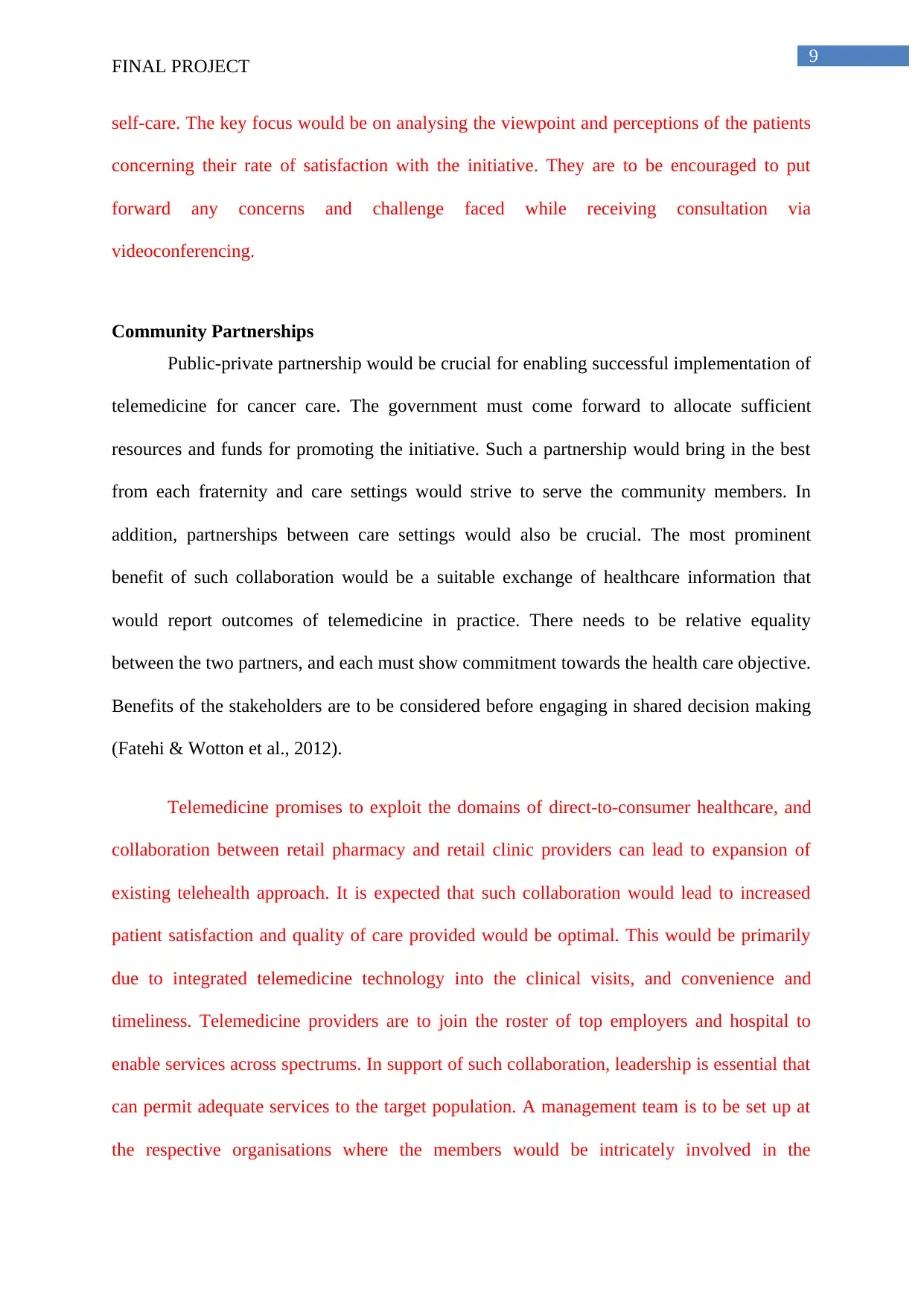
9
FINAL PROJECT
self-care. The key focus would be on analysing the viewpoint and perceptions of the patients
concerning their rate of satisfaction with the initiative. They are to be encouraged to put
forward any concerns and challenge faced while receiving consultation via
videoconferencing.
Community Partnerships
Public-private partnership would be crucial for enabling successful implementation of
telemedicine for cancer care. The government must come forward to allocate sufficient
resources and funds for promoting the initiative. Such a partnership would bring in the best
from each fraternity and care settings would strive to serve the community members. In
addition, partnerships between care settings would also be crucial. The most prominent
benefit of such collaboration would be a suitable exchange of healthcare information that
would report outcomes of telemedicine in practice. There needs to be relative equality
between the two partners, and each must show commitment towards the health care objective.
Benefits of the stakeholders are to be considered before engaging in shared decision making
(Fatehi & Wotton et al., 2012).
Telemedicine promises to exploit the domains of direct-to-consumer healthcare, and
collaboration between retail pharmacy and retail clinic providers can lead to expansion of
existing telehealth approach. It is expected that such collaboration would lead to increased
patient satisfaction and quality of care provided would be optimal. This would be primarily
due to integrated telemedicine technology into the clinical visits, and convenience and
timeliness. Telemedicine providers are to join the roster of top employers and hospital to
enable services across spectrums. In support of such collaboration, leadership is essential that
can permit adequate services to the target population. A management team is to be set up at
the respective organisations where the members would be intricately involved in the
FINAL PROJECT
self-care. The key focus would be on analysing the viewpoint and perceptions of the patients
concerning their rate of satisfaction with the initiative. They are to be encouraged to put
forward any concerns and challenge faced while receiving consultation via
videoconferencing.
Community Partnerships
Public-private partnership would be crucial for enabling successful implementation of
telemedicine for cancer care. The government must come forward to allocate sufficient
resources and funds for promoting the initiative. Such a partnership would bring in the best
from each fraternity and care settings would strive to serve the community members. In
addition, partnerships between care settings would also be crucial. The most prominent
benefit of such collaboration would be a suitable exchange of healthcare information that
would report outcomes of telemedicine in practice. There needs to be relative equality
between the two partners, and each must show commitment towards the health care objective.
Benefits of the stakeholders are to be considered before engaging in shared decision making
(Fatehi & Wotton et al., 2012).
Telemedicine promises to exploit the domains of direct-to-consumer healthcare, and
collaboration between retail pharmacy and retail clinic providers can lead to expansion of
existing telehealth approach. It is expected that such collaboration would lead to increased
patient satisfaction and quality of care provided would be optimal. This would be primarily
due to integrated telemedicine technology into the clinical visits, and convenience and
timeliness. Telemedicine providers are to join the roster of top employers and hospital to
enable services across spectrums. In support of such collaboration, leadership is essential that
can permit adequate services to the target population. A management team is to be set up at
the respective organisations where the members would be intricately involved in the
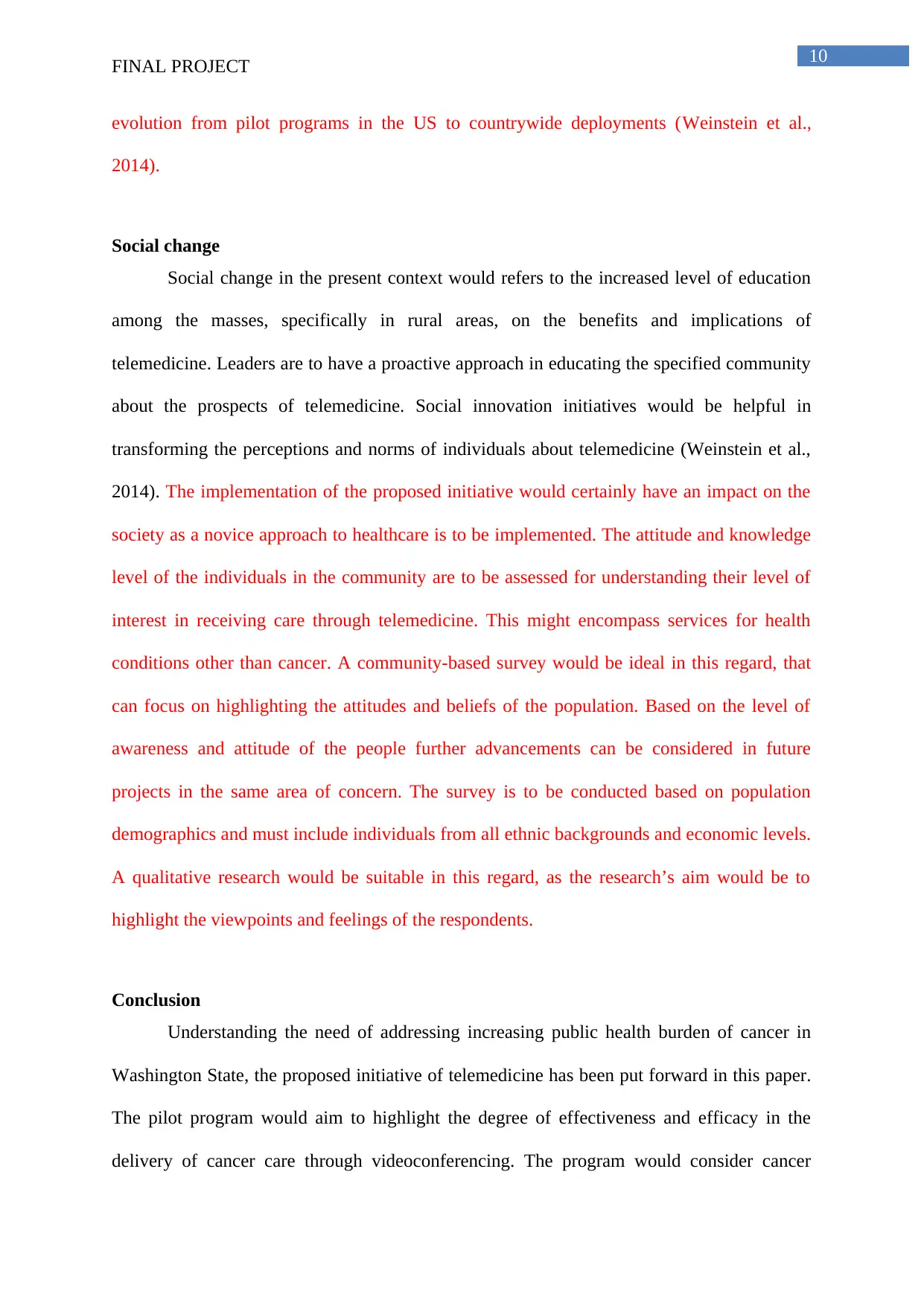
10
FINAL PROJECT
evolution from pilot programs in the US to countrywide deployments (Weinstein et al.,
2014).
Social change
Social change in the present context would refers to the increased level of education
among the masses, specifically in rural areas, on the benefits and implications of
telemedicine. Leaders are to have a proactive approach in educating the specified community
about the prospects of telemedicine. Social innovation initiatives would be helpful in
transforming the perceptions and norms of individuals about telemedicine (Weinstein et al.,
2014). The implementation of the proposed initiative would certainly have an impact on the
society as a novice approach to healthcare is to be implemented. The attitude and knowledge
level of the individuals in the community are to be assessed for understanding their level of
interest in receiving care through telemedicine. This might encompass services for health
conditions other than cancer. A community-based survey would be ideal in this regard, that
can focus on highlighting the attitudes and beliefs of the population. Based on the level of
awareness and attitude of the people further advancements can be considered in future
projects in the same area of concern. The survey is to be conducted based on population
demographics and must include individuals from all ethnic backgrounds and economic levels.
A qualitative research would be suitable in this regard, as the research’s aim would be to
highlight the viewpoints and feelings of the respondents.
Conclusion
Understanding the need of addressing increasing public health burden of cancer in
Washington State, the proposed initiative of telemedicine has been put forward in this paper.
The pilot program would aim to highlight the degree of effectiveness and efficacy in the
delivery of cancer care through videoconferencing. The program would consider cancer
FINAL PROJECT
evolution from pilot programs in the US to countrywide deployments (Weinstein et al.,
2014).
Social change
Social change in the present context would refers to the increased level of education
among the masses, specifically in rural areas, on the benefits and implications of
telemedicine. Leaders are to have a proactive approach in educating the specified community
about the prospects of telemedicine. Social innovation initiatives would be helpful in
transforming the perceptions and norms of individuals about telemedicine (Weinstein et al.,
2014). The implementation of the proposed initiative would certainly have an impact on the
society as a novice approach to healthcare is to be implemented. The attitude and knowledge
level of the individuals in the community are to be assessed for understanding their level of
interest in receiving care through telemedicine. This might encompass services for health
conditions other than cancer. A community-based survey would be ideal in this regard, that
can focus on highlighting the attitudes and beliefs of the population. Based on the level of
awareness and attitude of the people further advancements can be considered in future
projects in the same area of concern. The survey is to be conducted based on population
demographics and must include individuals from all ethnic backgrounds and economic levels.
A qualitative research would be suitable in this regard, as the research’s aim would be to
highlight the viewpoints and feelings of the respondents.
Conclusion
Understanding the need of addressing increasing public health burden of cancer in
Washington State, the proposed initiative of telemedicine has been put forward in this paper.
The pilot program would aim to highlight the degree of effectiveness and efficacy in the
delivery of cancer care through videoconferencing. The program would consider cancer
Secure Best Marks with AI Grader
Need help grading? Try our AI Grader for instant feedback on your assignments.
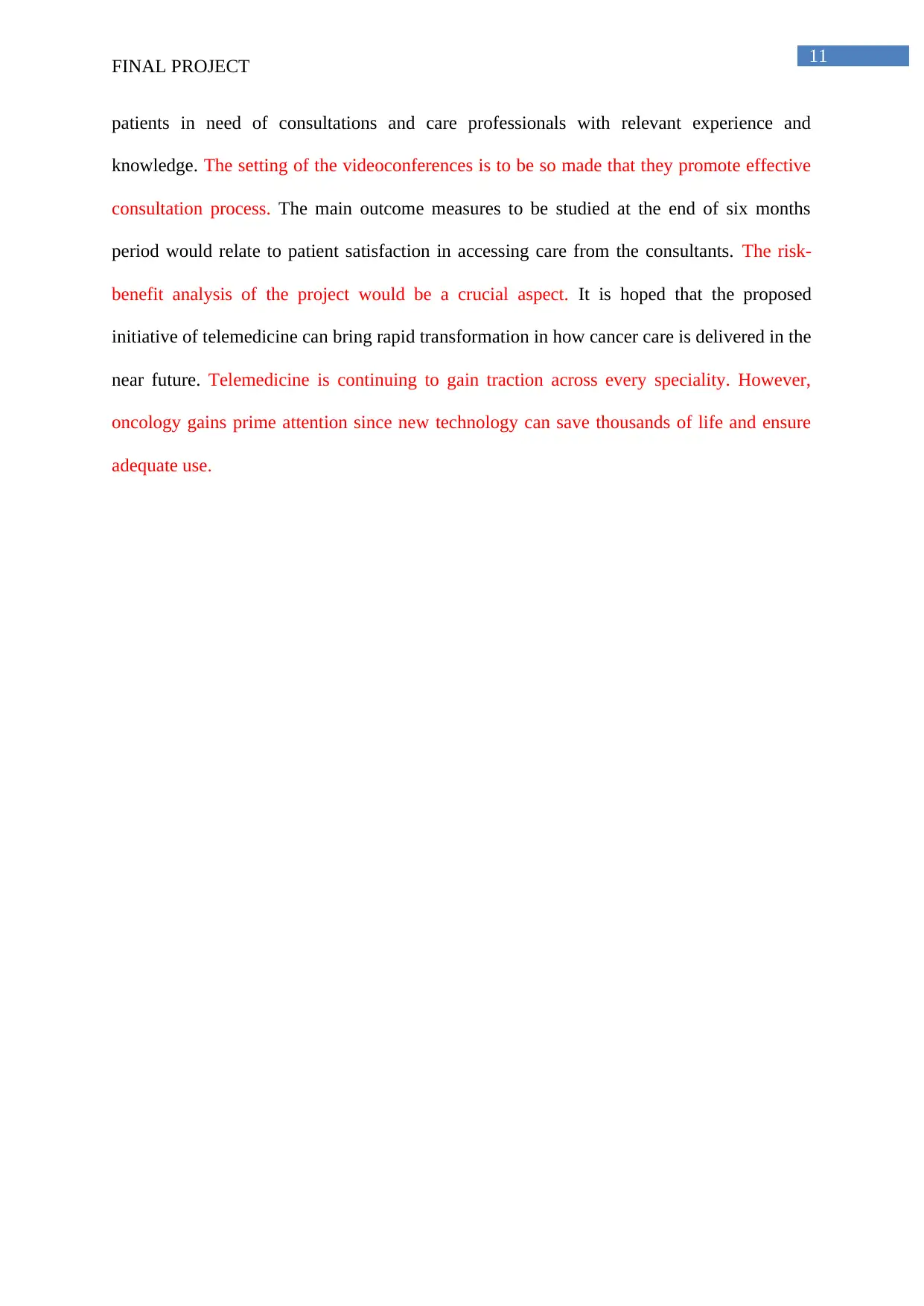
11
FINAL PROJECT
patients in need of consultations and care professionals with relevant experience and
knowledge. The setting of the videoconferences is to be so made that they promote effective
consultation process. The main outcome measures to be studied at the end of six months
period would relate to patient satisfaction in accessing care from the consultants. The risk-
benefit analysis of the project would be a crucial aspect. It is hoped that the proposed
initiative of telemedicine can bring rapid transformation in how cancer care is delivered in the
near future. Telemedicine is continuing to gain traction across every speciality. However,
oncology gains prime attention since new technology can save thousands of life and ensure
adequate use.
FINAL PROJECT
patients in need of consultations and care professionals with relevant experience and
knowledge. The setting of the videoconferences is to be so made that they promote effective
consultation process. The main outcome measures to be studied at the end of six months
period would relate to patient satisfaction in accessing care from the consultants. The risk-
benefit analysis of the project would be a crucial aspect. It is hoped that the proposed
initiative of telemedicine can bring rapid transformation in how cancer care is delivered in the
near future. Telemedicine is continuing to gain traction across every speciality. However,
oncology gains prime attention since new technology can save thousands of life and ensure
adequate use.
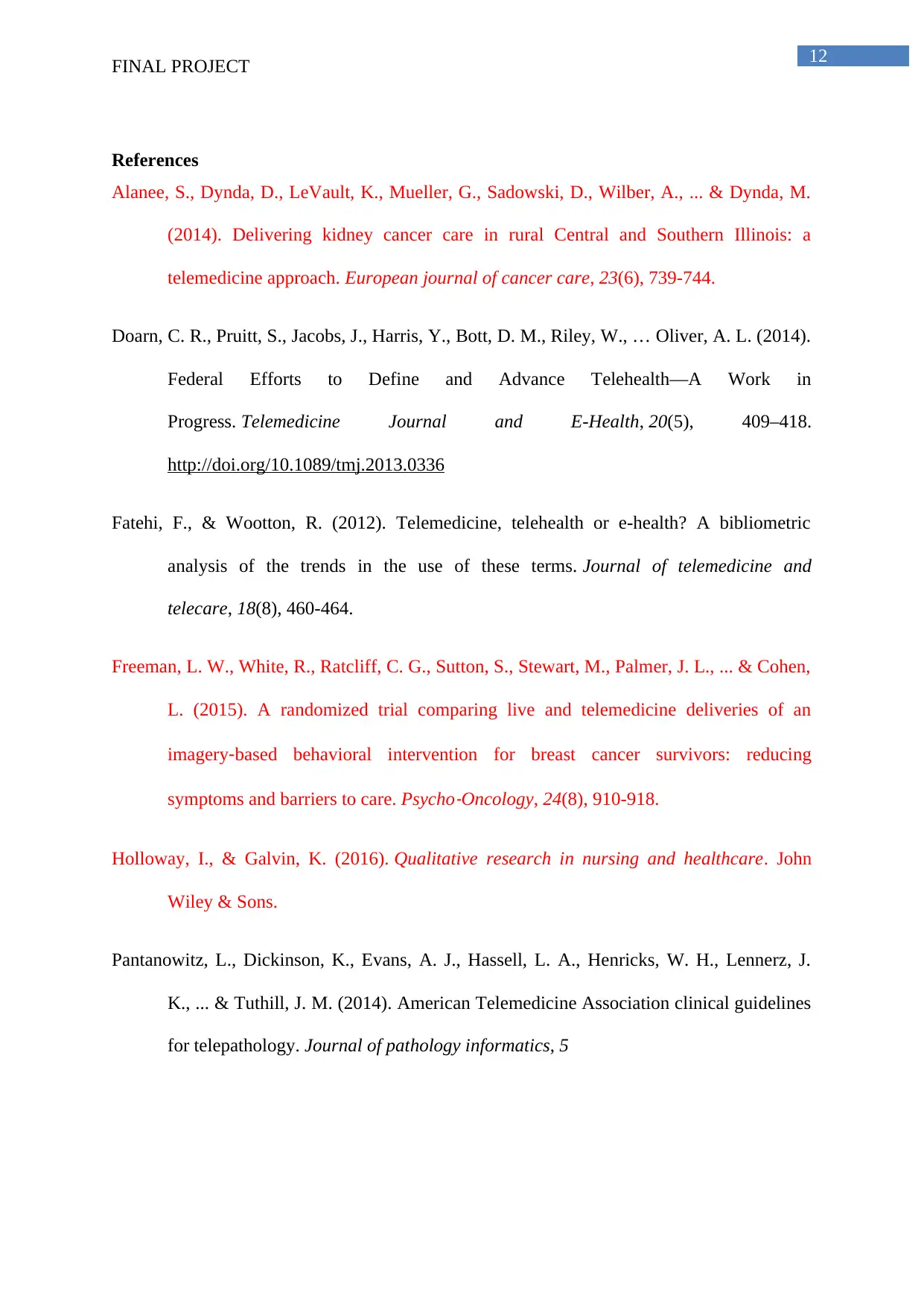
12
FINAL PROJECT
References
Alanee, S., Dynda, D., LeVault, K., Mueller, G., Sadowski, D., Wilber, A., ... & Dynda, M.
(2014). Delivering kidney cancer care in rural Central and Southern Illinois: a
telemedicine approach. European journal of cancer care, 23(6), 739-744.
Doarn, C. R., Pruitt, S., Jacobs, J., Harris, Y., Bott, D. M., Riley, W., … Oliver, A. L. (2014).
Federal Efforts to Define and Advance Telehealth—A Work in
Progress. Telemedicine Journal and E-Health, 20(5), 409–418.
http://doi.org/10.1089/tmj.2013.0336
Fatehi, F., & Wootton, R. (2012). Telemedicine, telehealth or e-health? A bibliometric
analysis of the trends in the use of these terms. Journal of telemedicine and
telecare, 18(8), 460-464.
Freeman, L. W., White, R., Ratcliff, C. G., Sutton, S., Stewart, M., Palmer, J. L., ... & Cohen,
L. (2015). A randomized trial comparing live and telemedicine deliveries of an
imagery‐based behavioral intervention for breast cancer survivors: reducing
symptoms and barriers to care. Psycho
‐Oncology, 24(8), 910-918.
Holloway, I., & Galvin, K. (2016). Qualitative research in nursing and healthcare. John
Wiley & Sons.
Pantanowitz, L., Dickinson, K., Evans, A. J., Hassell, L. A., Henricks, W. H., Lennerz, J.
K., ... & Tuthill, J. M. (2014). American Telemedicine Association clinical guidelines
for telepathology. Journal of pathology informatics, 5
FINAL PROJECT
References
Alanee, S., Dynda, D., LeVault, K., Mueller, G., Sadowski, D., Wilber, A., ... & Dynda, M.
(2014). Delivering kidney cancer care in rural Central and Southern Illinois: a
telemedicine approach. European journal of cancer care, 23(6), 739-744.
Doarn, C. R., Pruitt, S., Jacobs, J., Harris, Y., Bott, D. M., Riley, W., … Oliver, A. L. (2014).
Federal Efforts to Define and Advance Telehealth—A Work in
Progress. Telemedicine Journal and E-Health, 20(5), 409–418.
http://doi.org/10.1089/tmj.2013.0336
Fatehi, F., & Wootton, R. (2012). Telemedicine, telehealth or e-health? A bibliometric
analysis of the trends in the use of these terms. Journal of telemedicine and
telecare, 18(8), 460-464.
Freeman, L. W., White, R., Ratcliff, C. G., Sutton, S., Stewart, M., Palmer, J. L., ... & Cohen,
L. (2015). A randomized trial comparing live and telemedicine deliveries of an
imagery‐based behavioral intervention for breast cancer survivors: reducing
symptoms and barriers to care. Psycho
‐Oncology, 24(8), 910-918.
Holloway, I., & Galvin, K. (2016). Qualitative research in nursing and healthcare. John
Wiley & Sons.
Pantanowitz, L., Dickinson, K., Evans, A. J., Hassell, L. A., Henricks, W. H., Lennerz, J.
K., ... & Tuthill, J. M. (2014). American Telemedicine Association clinical guidelines
for telepathology. Journal of pathology informatics, 5
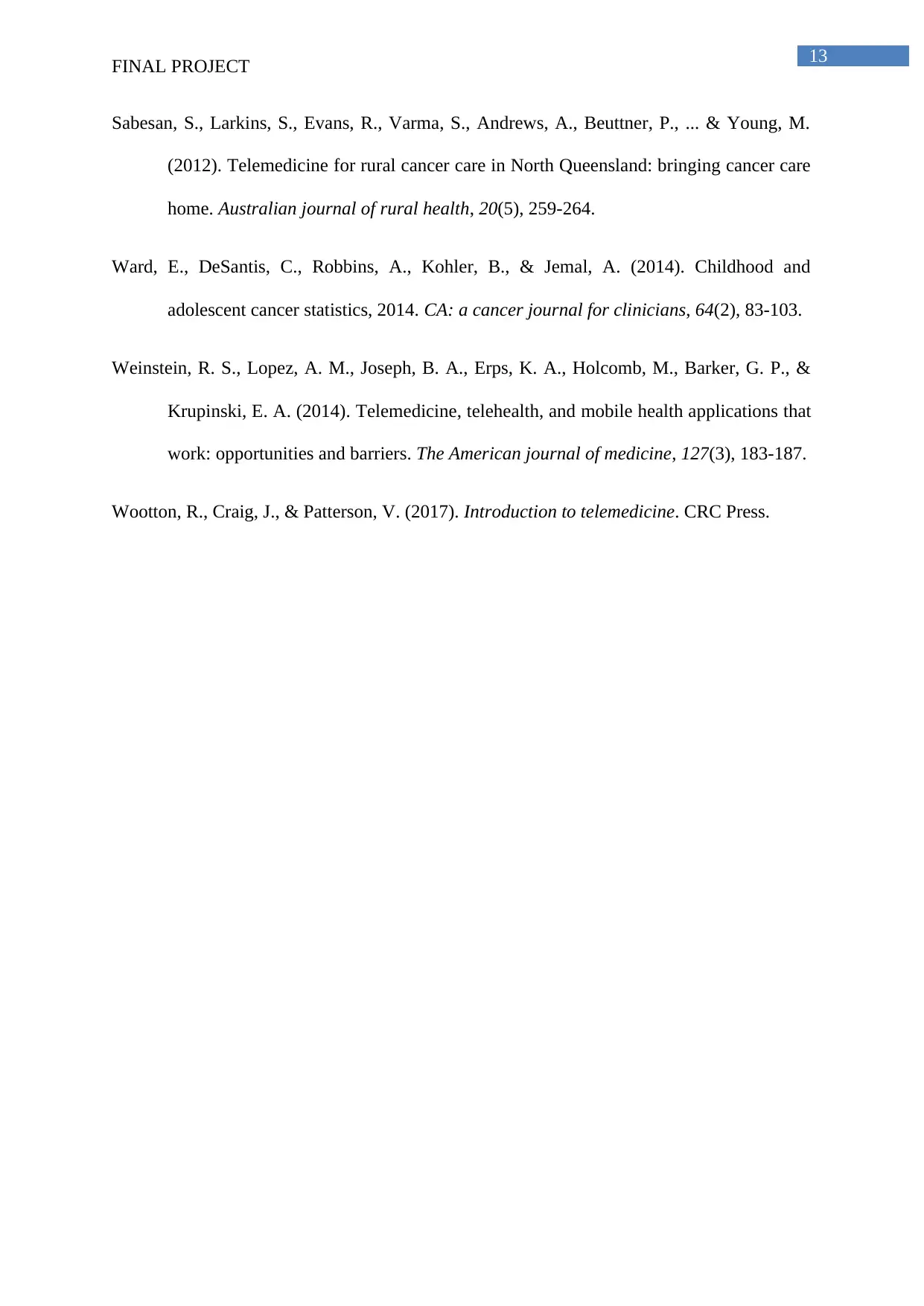
13
FINAL PROJECT
Sabesan, S., Larkins, S., Evans, R., Varma, S., Andrews, A., Beuttner, P., ... & Young, M.
(2012). Telemedicine for rural cancer care in North Queensland: bringing cancer care
home. Australian journal of rural health, 20(5), 259-264.
Ward, E., DeSantis, C., Robbins, A., Kohler, B., & Jemal, A. (2014). Childhood and
adolescent cancer statistics, 2014. CA: a cancer journal for clinicians, 64(2), 83-103.
Weinstein, R. S., Lopez, A. M., Joseph, B. A., Erps, K. A., Holcomb, M., Barker, G. P., &
Krupinski, E. A. (2014). Telemedicine, telehealth, and mobile health applications that
work: opportunities and barriers. The American journal of medicine, 127(3), 183-187.
Wootton, R., Craig, J., & Patterson, V. (2017). Introduction to telemedicine. CRC Press.
FINAL PROJECT
Sabesan, S., Larkins, S., Evans, R., Varma, S., Andrews, A., Beuttner, P., ... & Young, M.
(2012). Telemedicine for rural cancer care in North Queensland: bringing cancer care
home. Australian journal of rural health, 20(5), 259-264.
Ward, E., DeSantis, C., Robbins, A., Kohler, B., & Jemal, A. (2014). Childhood and
adolescent cancer statistics, 2014. CA: a cancer journal for clinicians, 64(2), 83-103.
Weinstein, R. S., Lopez, A. M., Joseph, B. A., Erps, K. A., Holcomb, M., Barker, G. P., &
Krupinski, E. A. (2014). Telemedicine, telehealth, and mobile health applications that
work: opportunities and barriers. The American journal of medicine, 127(3), 183-187.
Wootton, R., Craig, J., & Patterson, V. (2017). Introduction to telemedicine. CRC Press.
1 out of 13
Related Documents
Your All-in-One AI-Powered Toolkit for Academic Success.
+13062052269
info@desklib.com
Available 24*7 on WhatsApp / Email
![[object Object]](/_next/static/media/star-bottom.7253800d.svg)
Unlock your academic potential
© 2024 | Zucol Services PVT LTD | All rights reserved.




